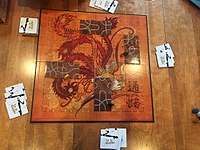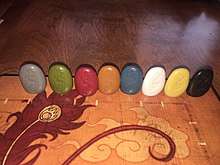Tsuro
 Tsuro board | |
| Designer(s) | Tom McMurchie |
|---|---|
| Publisher(s) | Calliope Games |
| Players | 2-8 |
| Playing time | 15 minutes |
Tsuro is a tile-based board game designed by Tom McMurchie, originally published by WizKids and now published by Calliope Games.
Tsuro is a board game for two to eight players. To play, players compete to have the last playing piece remaining on the board. Player turns consist of placing tiles on the board from the player’s hand. Then they move their respective pieces along these paths. Players are eliminated by following a path that ends at the board edge.
There have also been a number of differently themed Tsuro editions and expansions released, beginning with Tsuro of the Seas. Although core gameplay remains the same, some of versions feature expanded rules or larger boards.
Gameplay

The game is played on a square board that is divided into a six-by-six grid of squares. Before the game begins, each player chooses a different colored playing piece and places them on any of the white notches that surround the edge of the board. Each player also holds three tiles. After each turn, they draw another card. There are thirty-five standard tiles and one Dragon tile.
To play, the player must place a tile in the square in front their piece. Once placed, the piece moves along the line in front of it. If another player places a tile that connects to the line the player’s piece is on, the player must move their piece to the end of the line. Sometimes this will cause the piece to go off the board, in which the player is eliminated. If two pieces end up on the same path, both players are out.
The Dragon tile is only used when there are three or more players. When there are no more tiles to draw from, the player takes the Dragon tile. This is to indicate that they will be the first one to draw from the deck after the eliminated players give up their unplayed tiles.
Alternate Editions and Expansions
After Calliope Games began publishing Tsuro, different versions and spin-offs of the game were created. The game also has an App created by Thunderbox Entertainment. There were different languages made for the game including a German, a Greek and a multilingual version. The first Tsuro spin-off created was Tsuro of the Seas. The game was published by Calliope Games in 2012.[1] The game’s creators included the original creator of Tsuro, Tom McMurchie, and another board game designer named Jordan Weisman.[1]
Tsuro of the Seas has a few different gameplay aspects as well as different pieces. The game board is blue and slightly larger than the original board, with a seven by seven square pattern instead of six by six. The player’s individual pieces are also represented by different color ships, instead of the dragon engraved stones. The path tiles are blue and represent the same movement, but there are daikaiju tiles to go along with them now. Unlike the original game, Tsuro of the Seas includes a gold and blue die that is used to decide the starting placement of the daikaiju tiles and their movement every turn.[2]
The daikaiju tiles are dragons that move on the board every turn and are the greatest difference between Tsuro of the Seas and the original game Tsuro. Daikaiju tiles move at the start of every turn, giving the game a constantly changing board. Players try and avoid these tiles during the game, and if they run into them, they are destroyed and lose the game.[2]
Tsuro of the Seas later received an expansion called Veterans of the Seas, published in 2013 by Calliope Games.[3] This expansion includes four new types of tiles that all do different things. There is the mystical portal tile that moves ships and daikaiju tiles to new paths on the board. The tsunami tile moves steadily across the board, giving players a new obstacle they must overcome by rolling a die. If the player does not roll high enough they are eliminated from the game. The whirlpool tile destroys all ships and daikaiju tiles it comes in contact with. The cannon tiles are a defensive card players can use to defend themselves from daikaiju.[3]
The German version of Tsuro was published in 2007 by WizKids.[4] This version of the game was called KOSMOS. Besides the language, the game’s individual player pieces were little tree figures instead of the dragon stones.
Tsuro also has a Star Wars spin-off called Asteroid Escape. This version of Tsuro was published in 2011 by Abysse Corp.[5] Even though it was published before Tsuro of the Seas, it has all the same rules and has a spaceship and asteroid theme. In this game the daikaiju tiles are replaced with asteroid tiles and player’s individual pieces are cardboard spaceships instead of boats.[5]
References
- 1 2 "Tsuro of the Seas". Casual Game Revolution. Retrieved 2017-12-04.
- 1 2 "The Monsters at the Edge of the World: A Review of Tsuro of the Seas". Casual Game Revolution. Retrieved 2017-12-04.
- 1 2 "Tsuro of the Seas: Veterans of the Seas". BoardGameGeek. Retrieved 2017-12-04.
- ↑ "Tsuro". BoardGameGeek. Retrieved 2017-12-04.
- 1 2 "Asteroid Escape". BoardGameGeek. Retrieved 2017-12-04.
External links
- Official site
- Tsuro at BoardGameGeek
- Tsuro rules from 2009 at calliopegames.com